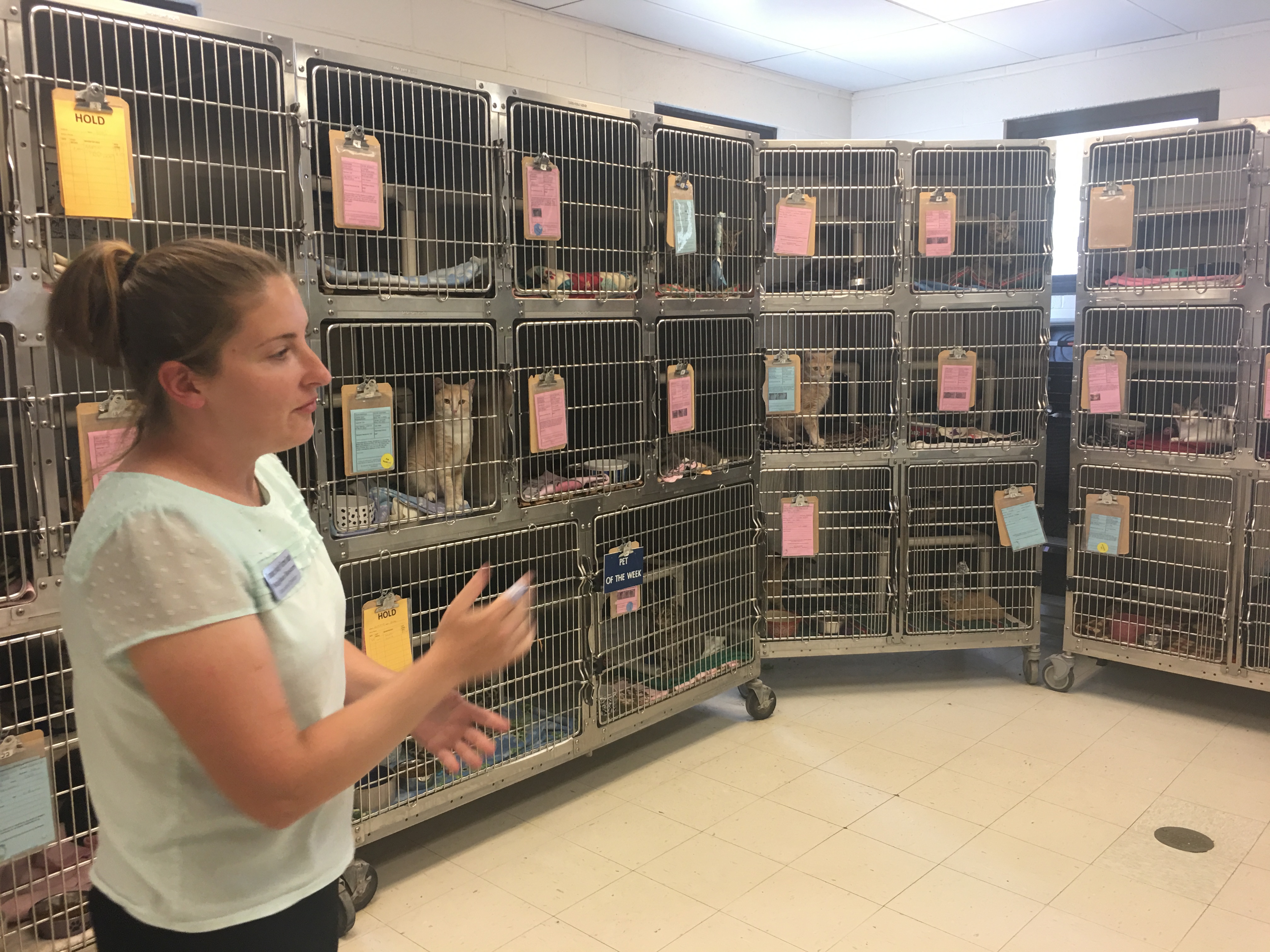On Monday, I hitched up the wagons and drove to town. (That’s what Nick likes to say every time I say I need to go ‘to town’ which is 10 miles away.) I was headed to the Warren County Humane Society, aka, the Warren County Animal Shelter.

I was signing up two of ‘my’ four cats to be neutered/spayed and vaccinated for rabies.
They were abandoned by the former owner of the little cabin we bought in the mountains of Virginia. One was clearly his cat, the other three are pretty feral. I was certain I could catch the one, but hopeful I could trap at least one other. So, for now, I’d pay for two.
We’re doing this in stages, since at their ‘low-cost,’ two cats will set me back nearly $200. This is important to me, so I will pay it. But it does give me sympathy for the people who can’t pay their own bills and so doesn’t spay/neuter their pet.
Since I would already be there, I’d made an appointment to speak to their executive director. I wanted to get the lay of the land in terms of animal rescue in my future hometown.
The paperwork for my cats took longer than expected, so Meghan only had about fifteen minutes for me, but she welcomed me into her office where Otto, a semi-feral, but awfully cute and lazy brown dog lounged on a bed beside her desk. “We’re trying to get him used to being around people,” she said. Otto ignored me. He was not the least bit alarmed by my presence, so I’d say it’s working.
Meghan, a young, professional, efficient woman, is a hands-on director who is on a first name basis with all the animals. I was impressed by the clean, well-stocked facility and even more impressed that their dog kennels were not full and they had such a large staff (20). According to their Asilomar report to Maddie’s Fund, Warren County took in about 1200 animals in 2018, more cats than dogs, but not significantly. Of those 1200, 56 healthy animals were euthanized (I didn’t count the untreatable, unmanageable). Not perfect numbers, but better than the previous year’s report, so the County is improving (even though the number of animals they took in increased by 20%).
Technically, Warren County is an open intake shelter (meaning they have to take any/all animals surrendered by the public and/or brought in by the sheriff’s office), but they do ask people to make appointments to surrender pets and they try to counsel them if possible. I wondered about surrendering my cats, but she was quick to say that the shelter doesn’t accept stray cats. (The sheriff’s office had already told me they don’t ‘deal with cats’ unless they are sick or injured.)
Meghan explained that Warren County’s budget is $637,000 and that they don’t struggle financially as a portion of their budget is provided by a trust created in 1947 when a woman named Julie Wagner created the Humane Society and endowed it. The rest of the budget comes from the community and the county budget. I was happy to hear that this animal-loving area donates so much food that the shelter hasn’t had to purchase any yet this year.
Later that same day while walking around the county fair, I met a woman running for office who told me the county pays $330,000 a year for the shelter. She wonders if that isn’t excessive and wants to see where all that money goes. I’d kind of like to know too, but because the shelter is not the county’s, but the Humane Society’s, that budget isn’t public. I’d like to know how much of that budget goes to the TNR program that is already out of money midpoint through the year (and thus can’t help me out with my three feral cats).
I asked Meghan what the biggest need was for the shelter and without hesitating she said feral cats are their biggest problem. Clearly. I don’t know her well enough (yet) to suggest that they double or triple their TNR funds if they are serious about tackling it. I also wondered to myself whether the high cost of their low-cost spay/neuter program might be a contributing factor.
To be fair, Meghan is new here and I would guess she needs time to push her own initiatives. Clearly, she loved each of her charges, rattling off names and histories as we looked in the kennels. There were four cat rooms and two rows of dog kennels. Warren County could house 35 dogs and 100 cats if they were full (they were not).


Each of the dog runs is indoor/outdoor, with the indoor floor heated when needed. There were brass plates on each kennel indicating which business or individual sponsored that kennel. The dogs were friendly and excited to see us. Meghan greeted each one and knew its story. She told me they take in dogs from several other county shelters, particularly pit-bull type dogs because “We’re really good with pit bulls.” This is perhaps the first shelter I’ve encountered that places pit bulls easily.
There were no volunteers that day and Meghan said they have a handful of dedicated volunteers who come to walk the dogs, she wishes there were more.
Leaving the building with instructions on where to bring my captured kitties on Wednesday, I was relieved that my local shelter has achieved a ‘no-kill’ status (94% of better save rate) for many years and that they seem to be fully funded. Sure, I’d like to see some of those funds go towards spay/neuter (beyond the underfunded TNR, they adopt out dogs and cats unaltered and expect the adopter to take care of it – sometimes a naive assumption, particularly knowing now what constitutes ‘low cost’ spay and neuter.). But for the most part, the county shelter is thriving and meeting the needs of the homeless animals in the area.
Curious about the other shelter south of me about the same distance, I contacted the Page County shelter and set up a time to visit and talk to its director.
The small shelter sits amongst some of the most beautiful country I know.
Jami greeted me at the door, and knowing she was pressed for time (2 of the five employees were out sick), we dove right in. Jamie has been with the Page County Animal Shelter for fifteen years; she started there the year after it was built. Back then they could have as many as 1200 cats, she told me, plus hundreds of dogs. I asked what the euthanasia rate was and she shook her head and said, “It was bad, probably 800 of those cats had to be euthanized.”
Last year, Page County was a no-kill shelter with a save rate better than 94%. As we talked, I was amazed at how much this humble woman gets done on a budget only a third of Warren County’s. Now, thanks to successful TNR (trap-neuter-release) programs, people rehoming their pets on Facebook, and hard work of Jami and her staff, they only took in about 600 animals in 2018 (half dogs, half cats).
They move their animals out through rescues and also through adoptions, although she admitted they don’t get a lot of food traffic. I was there for an hour and in that time, one family came to surrender their cat (they have a new baby coming and are worried it will bite it), and two other couples came to look for a pet. There were only eight dogs in the kennels that day because a rescue from Maryland had come through over the weekend and taken a vanful. Jami actively seeks out rescues and local organizations to work with. Page County Paws (a local nonprofit) handles their TNRs, and she rattled off a list of other rescues she interacts with. “You have to work with other people,” she says. “You can’t do this without help.”
The local community, while small and rural, is very supportive. They are inundated with donations of food, newspapers, cleaning products, etc.
For such a small shelter, Jami has succeeded in being a big presence in the county. She developed her own program that she takes into schools to talk to kids about shelter animals and how to safely interact with animals. She reads a story, hands out coloring pages and awards each child with a “I’m a kind kid” sticker at the end. I was shaking my head again and again as I listened to all that this woman does.
What probably impressed me the most about Jami was her dedication to the health of the animals. Most shelters do the minimum in terms of health care. Budgets rarely cover more than that, but Jami finds a way to stretch her dollar. Having worked with a local vet for fourteen years before coming to the shelter, she has maintained that relationship and been able to get their vet work done at a minimum. As she goes through the book and shows me a five-year-old cat that just had eye surgery and an 8-year-old cat that has had multiple veterinary appointments, I comment on this. She says, “If I have money, I’ll do it. If I can find a way, I’ll fix it.”
Unlike Warren County, most of their animals leave the building already spayed or neutered. Page County will also treat heartworm positive animals. Watching Jami interact with the family surrendering the cat, listening patiently, being absolutely professional and fair, I was even more impressed. I listened to the story and it made me angry, but if Jami was angry, she gave nothing away. I have a feeling that’s how she’s stayed so long in this job. She focuses on the animals and not the circumstances that brought them here.
I’ve often wondered and written a few times about ‘the line.’ That invisible line in this country between where the animals are valued and saved no matter what and where they can die for lack of funds or space or caring. I have a feeling I am treading closer to it here in the mountains of Virginia, but clearly, as long as Jami is in charge, that line is further south than Page County.
I’m headed south again in a month, back to Tennessee, and then on to Alabama. There are so many stories to tell, so many animals to see, but here in the mountains of Virginia I am awed once again by the heroes, like Jami. Clearly, a shelter doesn’t need a big budget or a fancy building to save animals (although they are awfully nice to have and likely lower staff turnover), what they mostly need is committed, caring leaders who focus on what they can do rather than what they cannot; people who are willing to wear out their own hearts doing all they can to save the animals placed in their path.
I’m here to tell their stories.If you’d like to follow along, be sure to subscribe to this blog or follow our Facebook page.
Blessings,
Cara
“Together we can let the dogs out.”
If you’d like to know more about me and my writing, visit CaraWrites.com.
If you’d like to know more about my latest book, Another Good Dog: One Family and Fifty Foster Dogs, visit AnotherGoodDog.org.





Paul Handover
A brilliant examination of the shelter.
Cara Sue Achterberg
Thanks!
Leslie
I appreciate how Cara digs deeper to get the knowledge and create awareness.
Cara Sue Achterberg
Awareness is the first step to change!